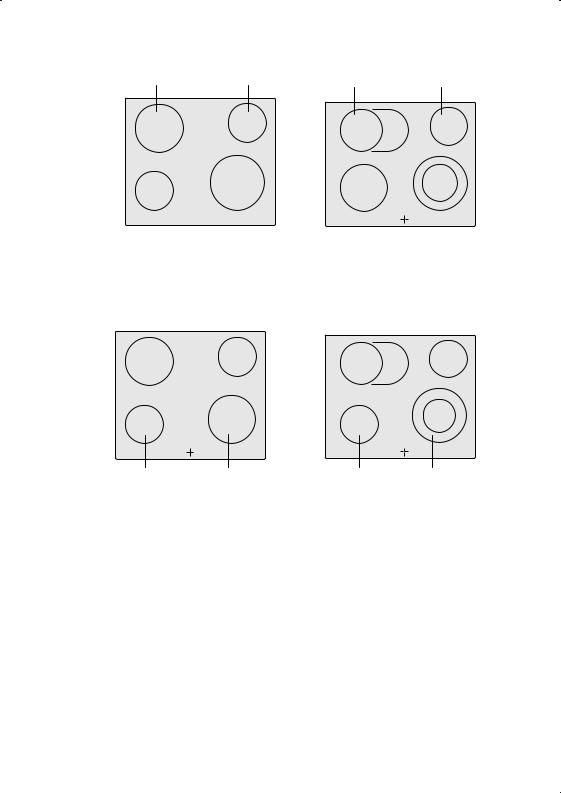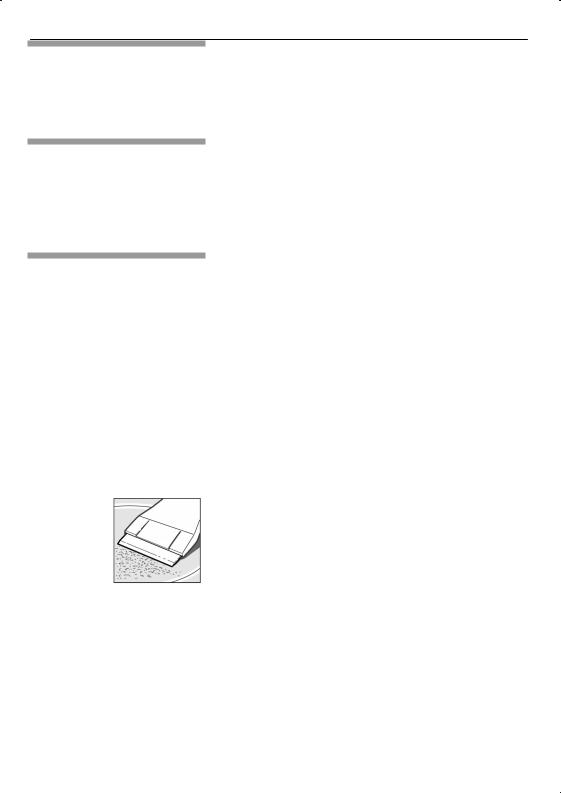Siemens cm310, cm313, cm330, cm333, cm343 Instruction Manual

|
! ! |
|
|
|
|
|
|
|
|
4 |
|
|
|
|||
|
! |
|
|
! |
|
|
|
|
|
|
5 |
8 |
|
|
||
" |
! " |
|
|
|
|
|
|
|
|
|
|
|
4 |
|
|
|
|
|
|
|
|
|
|
|
|
|
|
|
|
|
|
|
|
! !
! ! ! "
4
4 8

|
CM |
313.. |
CM |
333.. |
CM343.. |
8 |
|
|
|
7 |
|
|
|
|
|
|
|
|
|
|
|
|
|
|
|
|
|
|
|
|
|
|
|
|
|
|
|
|
|
|
|
|
|
|
|
|
|
|
|
|
|
|
|
|
|
|
|
|
|
|
|
|
|
|
|
|
|
|
|
|
8 |
|
|
||
|
|
|
|
|
|
|
|
|
|
|
|||||
|
|
|
|
|
|
|
CM |
310.. |
CM |
330.. |
|
|
|
||
|
|
|
|
|
|
|
|
|
|
|
|
|
|||
|
8 |
|
|
|
|
|
|
7 |
|
|
|
||||
|
|
|
|
|
|
|
|
|
|
|
|
||||
|
|
|
|
|
|
|
|
|
|
|
|
|
|
|
|
|
|
|
|
|
|
|
|
|
|
|
|
|
|
|
|
|
8 |
|
Ø = cm
2

Tab e f c e
I a f a . . . . . . . . . . . . . .4 . . . . . . . .
Before installation. . . . . . . . . . . . . . . . . . . . . . . . .
Safety information. . . . . . . . . . . . . . . . . . . . . . . . .
Reasons for damage. . . . . . . . . . . . . . . . . . . . . . .
Ge g w he a a .ce. . . . . . . . . . 7. . . .
The hotplates . . . . . . . . . . . . . . . . . .7 . . . . . . . .
Operating and residual heat indicator. . . . . . . . . . 8. .
Notes from the after(sales service. . . . . . . . . . . 8. . .
C g . . . . . . . . . . . . . . . . . . . 9. . . . . . . . .
Setting procedure. . . . . . . . . . . . . . . . 9. . . . . . . . .
Table . . . . . . . . . . . . . . . . . . . . .9 . . . . . . . . .
Tips on saving energy. . . . . . . . . . . . . . . .0. . . . . . .
Ca e a d c ea g. . . . . . . . . . . . . . . 11. . . . . . . . .
Care . . . . . . . . . . . . . . . . . . . . . . . . . . . . . .
Cleaning glass ceramic. . . . . . . . . . . . . . . . . . . . . .
Cleaning the hob surround. . . . . . . . . . . . . . . . . . . .
Pac ag g |
a d d a a ce. . . . . . . . . . 12. . . . . |
|||||
|
|
|
|
|
|
|
Af e $ a e e v ce. . . . . . . . . . |
. . . |
. |
.13. . . . . . . . . |
|||
|
|
|
|
|
||
Ac y a de f .d . . . . . . . . . |
. . . |
. |
. 13. . . . . . . . . |
|||
|
|
|
||||
What can |
you do?. . . . . . . . . . . . . . . . . . . . . . . . |
|||||
3

Important information
Read |
this instruction manual |
carefully. Only then wil |
you |
be able to operate your |
hob safely and correc |
Keep the instruction and installation manual and the appliance pass in good condition. Please pass on these documents to the new owner if you sell the appliance.
Before installation
Transport damage Check the hob after unpacking it. Do not connect appliance if it has been damaged in transport.
Electrical connection The hob may only be connected by a licensed specialist. Damage due to the appliance being connected incorrectly will invalidate the guarantee.
Safety information
|
This appliance |
is intended only for domestic use. |
||
|
Only use the hob for food preparation. |
|||
Overheated oil and fat |
Overheated |
oil |
or fat can ignite very quickly. |
|
|
Risk of fire! |
|
||
|
Never leave heating oil or fat unsupervised. |
|||
|
Should |
the oil |
ignite, do not try to put it out by |
|
|
water |
on |
it. |
|
|
Cover the pan with a lid or plate immediately. |
|||
|
Switch |
off |
the |
hotplate. |
|
Leave |
the |
ovenware on the hotplate to cool down. |
|
Hot hotplates |
Do not touch |
hot hotplates. There is a risk of bur |
||
|
Children must be kept at a safe distance from the |
|||
|
appliance. |
The |
residual heat indicator warns you tha |
|
|
the hotplates are hot. |
|||
|
Never place combustible items on the hob. |
|||
|
Risk of fire! |
|
||
|
The service cables from electrical appliances must n |
|||
|
touch |
the |
hot |
hotplates. This could cause damage |
|
the hob and |
the cable insulation. |
||
4

Wet saucepan bases and Steam pressure can be generated from the liquid
hotplates |
|
between the base of the saucepan and |
the |
hotplat |
||
|
|
The steam pressure could cause the pan to jump |
||||
|
|
suddenly. There is a risk of injury. |
|
|
|
|
|
|
Always keep the hotplate and the bases |
of |
saucep |
||
|
|
dry. |
|
|
|
|
Cracks in |
the glass |
ceramicIf there are fractures, flaws or cracks in |
the |
cerami |
||
|
|
there is a risk of electric shock. |
|
|
|
|
|
|
Switch off the appliance immediately. |
|
|
|
|
|
|
Isolate the appliance from the power supply |
at |
the |
||
|
|
fuse |
box. |
|
|
|
|
|
Call |
after'sales service. |
|
|
|
Incorrect |
repairs |
Incorrect repairs are dangerous. There is |
a risk |
of |
||
|
|
electrocution. |
|
|
|
|
|
|
Repairs may only be carried out by one of our |
|
|||
|
|
experienced after'sales engineers. |
|
|
|
|
Reasons for damage
Saucepan and pan bases Rough pan bases scratch the glass ceramic. Check your ovenware.
Avoid cooking on the hob with an empty pan, especially with enamel and aluminium pans. This could cause damage to the saucepan bases and glass ceramic.
Observe the manufacturer's instructions when using
special |
ovenware. |
|
|
|
Hot pans and saucepans Never |
place |
hot |
pans |
or saucepans on the control |
panel, |
display |
area or |
the frame. |
|
This could cause |
damage. |
|||
Salt sugar and sand Salt, sugar and sand cause scratches on the glass ceramic. Do not use the hob as a work surface o storage space.
Hard and pointed objects Damage can |
occur |
if hard |
or pointed |
objects fall o |
|
the |
hob. |
|
|
|
|
Do |
not store |
such |
objects |
above the |
hob. |
5

Food spills |
Sugar and |
food with a high sugar content damage |
|
hob. Remove food spills immediately with a glass |
|
|
scraper. |
|
|
Caution The |
glass scraper has a sharp blade. |
Foil and plastic
Examples of possible damage
Aluminium foil or plastic containers |
melt |
on |
hot hob |
Oven protective foil is not suitable |
for |
your |
hob. |
The following types of damage affect neither the cooker's function nor the stability of the glass ceramic.
Blisters
caused by melted sugar or food with a high sugar content.
Scratches
caused by salt, sugar or sand particles or from ro pan bases.
Shimmering metallic discoloration
caused by pan abrasion or the use of unsuitable cleaning agents.
Scuffed surface caused by using unsuitable cleaning agents.
6

Getting to know the appliance
The instruction manual applies to various hobs. An overview of models with dimensions is given on page 2.
The hotplates and indicators are described in this section. They are differentiated by appliance model.
The hotplates
Single circuit hotplate The cooking surface size of these hotplates cannot altered.
Select the correct hotplate.
The saucepan and hotplate sizes should match.
Dual circuit hotplate |
The |
size |
of these hotplates can be |
altered. |
|
|
|
|
To switch on the outer filament circuit: |
|
|
|
|||
|
Turn the hotplate control clockwise |
as far as |
the |
|
|||
|
symbol. Then set the desired heat |
setting |
at |
the |
s |
||
|
time. |
|
|
|
|
|
|
|
To switch |
off: |
|
|
|
|
|
|
Turn |
the |
hotplate control to 0 and |
reset. |
Never |
tur |
|
|
the hotplate control beyond thesymbol to 0. |
|
|
||||
Extended cooking zone |
The |
extended cooking zone can be |
switched |
on |
w |
||
|
using |
these hotplates. |
|
|
|
|
|
|
To switch on the extended cooking zone: |
|
|
|
|||
|
Turn the hotplate control clockwise |
as far as |
the |
|
|||
|
symbol. Then set the desired heat |
setting |
at |
the |
s |
||
|
time. |
|
|
|
|
|
|
|
To switch |
off: |
|
|
|
|
|
|
Turn |
the |
hotplate control to 0 and |
reset. |
Never |
tur |
|
|
the hotplate control beyond the symbol to |
0. |
|
|
|||
7

Operating and residual heat indicator
Using residual heat
Notes from the after sales service
The i operating |
and |
residual heat |
indicator |
lights up |
when you switch |
on |
a hotplate. |
After you |
have |
finished cooking it indicates residual heat. It goes
when |
the |
hotplate |
has cooled |
down sufficiently. |
You |
can |
use this |
residual heat |
economically e.g. to |
keep |
a small meal warm or to melt chocolate. |
|||
The |
hotplate temperature is controlled by switching |
|||
the heat on and off this means that it is not alw
possible |
to |
see |
the red glowing heat. |
If |
you |
select |
||
low heat setting the |
heat will switch |
off |
more |
ofte |
||||
than at |
higher |
heat |
settings. The heat |
also switches |
||||
on and |
off |
at |
the highest setting. |
|
|
|
|
|
There may |
be |
a gentle buzzing as the |
hotplates |
he |
||||
up. |
|
|
|
|
|
|
|
|
The heat may show differently on the individual |
|
|||||||
hotplates. Depending |
on the angle of |
vision the |
he |
|||||
may appear to spread beyond the marked boundary of the hotplate.
These are technical features and do not influence quality or function.
Depending on the surface area of the plate a sma
uneven gap may form between the plate and |
the |
For this reason the hob has an elastic seal |
all the |
round. |
|
Glass ceramic may display surface area irregularities
inherent to the material. The glassy |
surface |
area |
of |
hob means that tiny blisters with a |
diameter |
of |
les |
than mm appear with varying intensity. They do affect the function or the durability of the glass ceramic hob.
8

Cooking
This |
section describes how to adjust the hotplates. |
The |
table shows the heat settings and cooking time |
for various food dishes. The following tips help to s energy.
Setting procedure
Adjust the heat setting of the hotplate using the hotplate control.
0 = hotplate off hotplate 1 = lowest setting hotplate 9 = highest setting
Table
|
|
The |
following |
table provides |
a few examples. |
||||||
|
|
The cooking time may vary |
depending |
on the type |
|||||||
|
|
food its weight and quality. Deviations are therefore |
|||||||||
|
|
possible. |
|
|
|
|
|
|
|
|
|
|
|
|
|
|
|
|
|
|
|
||
|
|
m l s |
|
|
|
|
|
s |
|||
|
|
|
|
|
|
|
|
|
|
||
Melting |
|
chocolate, |
chocolate coating |
1 |
|
|
|
||||
|
|
gelatine |
|
|
1 |
|
|
|
|||
|
|
butter |
|
|
|
1 |
) |
2 |
|
||
|
|
|
|
|
|
|
|
|
|
|
|
Heating |
|
vegetables |
(tin) |
|
3 |
) |
4 |
|
|||
|
|
stock |
|
|
|
7 |
) |
8 |
|
||
|
|
|
|
|
|
|
|
|
|
|
|
Heating and keeping warm |
|
stew, |
e.g. |
lentil |
stew |
2 |
|
|
|
||
|
|
|
|
|
|
|
|
|
|
|
|
Sweating |
|
fish |
|
|
|
5 |
) |
6 |
|
||
|
|
|
|
|
|
|
|
|
|
|
|
Cooking |
|
rice |
|
|
|
3 |
|
|
|
||
|
|
potatoes boiled in their skins* |
3 |
) |
4 |
|
|||||
|
|
boiled |
potatoes* |
|
4 |
) |
5 |
|
|||
|
|
vegetables, |
fresh* |
|
4 |
) |
5 |
|
|||
|
|
vegetables, |
frozen |
4 |
|
|
|
||||
|
|
meat |
stock |
|
|
4 |
) |
5 |
|
||
9

|
|
m l s |
|
|
|
s |
||
|
|
|
|
|
|
|
|
|
Braising |
|
pot |
roast |
|
3 |
+ |
4 |
|
|
|
roulade |
|
3 |
+ |
4 |
||
|
|
|
|
|
|
|
|
|
Roasting |
|
pancakes |
(Flädle) |
5 |
+ |
6 |
||
|
|
fish |
fingers |
6 |
+ |
7 |
||
|
|
veal/pork |
cutlet |
7 |
+ |
8 |
||
* Minerals and vitamins are gradually lost to |
the |
water. For |
this |
reason, |
using small quantities |
|
water preserves the vitamins and minerals. |
Short |
cooking |
time |
+ crisp |
vegetables |
|
|
|
|
|
|
|
|
Tips |
on |
saving |
|
|
|
|
|
|
|
|
|
||
energy |
|
|
|
|
|
|
|
|
|
|
|
|
|
|
|
|
|
|
Use saucepans and pots with thick even bases. |
||||||||
|
|
|
|
|
Uneven bases increase the cooking time. |
|
|||||||
The correct |
saucepan |
size Select the |
correct saucepan size for each hotplate. |
||||||||||
|
|
|
|
|
The diameter of the bases of the saucepans and |
||||||||
|
|
|
|
|
should match the size of the hotplate. |
|
|||||||
|
|
|
|
|
Note: Ovenware manufacturers often give the |
||||||||
|
|
|
|
|
diameter |
of |
the top |
of |
the saucepan. It is usually |
||||
|
|
|
|
|
than |
the |
diameter of |
the base of the saucepan. |
|||||
|
|
|
|
|
Use |
a small saucepan |
for small quantities. A larger |
||||||
|
|
|
|
|
less full saucepan requires more energy. |
|
|||||||
Using |
a |
lid |
|
|
Saucepans |
and pots should always be covered with |
|||||||
|
|
|
|
|
suitable lid. Cooking without a lid requires much m |
||||||||
|
|
|
|
|
energy. |
|
|
|
|
|
|
|
|
Cooking |
with |
small |
Cook with small quantities of water This saves ener |
||||||||||
quantities |
of |
|
water |
and |
helps |
vegetables to retain vitamins and minerals |
|||||||
Lowering the heat setting Switch down to a lower heat |
setting in good time. |
||||||||||||
Using |
residual |
heat |
For |
longer |
cooking times switch off the hotplate 5 |
||||||||
|
|
|
|
|
10 minutes |
before |
the end of |
the cooking |
time. |
||||
|
|
|
|
|
As long |
as |
the |
residual |
heat |
indicator is |
lit you c |
||
|
|
|
|
|
use the hotplate which |
has already been |
switched |
||||||
|
|
|
|
|
off |
for warming |
up |
or |
melting food. |
|
|||
10

Care and cleaning
Do not use high pressure cleaners or steam jets.
Care
Clean your hob using a protective/care product for glass ceramic. It coats the cooking surface with a glossy, dirt,repellent film. Your hob will continue to look good for a long time. It makes cleaning easie
Cleaning glass ceramic
Clean the hob after each use. This prevents food being burnt into the hob surface.
Cleaning agents |
Only use cleaning agents which are suitable for |
gla |
|||
|
ceramic, e.g. CERA CLEAN, cera,fix, Sidol for |
|
|||
|
ceran + |
steel. |
|
|
|
|
Water marks can also |
be removed using lemon |
juic |
||
|
or |
vinegar. |
|
|
|
Unsuitable cleaning agents Do |
not use: |
|
|
||
|
Abrasive sponges, scouring pads or aggressive |
|
|||
|
cleaning agents, such as oven spray or stain remo |
||||
Glass scraper |
You can |
remove thick |
dirt best with a glass scrap |
||
|
Remove |
the protective |
cover from the glass scraper |
||
|
Only use the blade to |
clean the glass ceramic sur |
|||
|
The casing may scratch the ceramic surface. |
|
|||
The |
blade |
is very |
sharp. |
There is a risk of injury. |
|
the |
blade |
after cleaning. |
|
||
Replace damaged |
blades |
|
immediately. |
||
11

How to clean the glass ceramic cooking surface
Shimmering metallic discoloration
Use the glass scraper to remove food residues and grease splashes.
Use a cleaning product and kitchen towel to clean
surface when it |
is luke warm. |
If the |
surface is still |
hot it can become stained. |
|
|
|
Wipe the surface |
and rub dry |
with a |
soft cloth. |
Discoloration is caused by pan abrasion or the use unsuitable cleaning agents. This is very difficult to remove. Use Hob Clean or Sidol for ceran + steel. after0sales service can remove discoloration, but will charge for this service.
Cleaning the hob surround
Only use warm soapy water. |
|
Do not use anything which is sharp |
or abrasive. T |
glass scraper is unsuitable. The hob |
surround could |
be damaged. |
|
Neither lemon juice nor vinegar should be used for cleaning the hob surround.
This could result in matt patches.
Packaging and old appliances
Disposing in an environmentally responsible manner
Unpack |
the appliance and dispose of the packaging |
in an |
environmentally0responsible manner. |
óThis appliance is labelled in accordance with the European Directive 2002/96/EC concerning used
electrical and |
electronic appliances (waste electrical |
|
and electronic equipment - WEEE). |
||
The |
guideline |
determines the framework for the retu |
and |
recycling |
of used appliances as applicable. |
12
